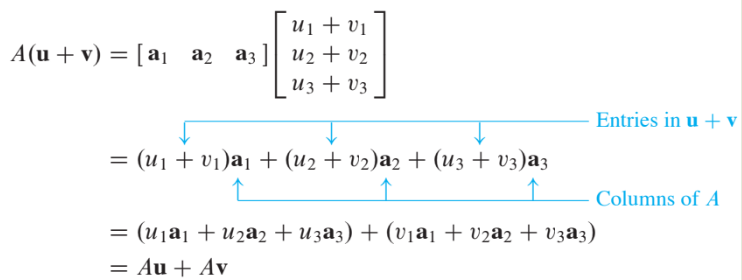Linear Equations in Linear Algebra
1.4 The Matrix Equation
A fundamental idea of linear algebra is to view a linear combination of vectors as the product of a matrix and a vector!!
Definition
If is an matrix, with columns , and if is in , then the product of and , denoted by is the linear combination of the columns of using the corresponding entries in as weights; that is,
Note that is defined only if the number of columns of equals the number of entries in . .
Example 2
For in , write the linear combination as a matrix times a vector.
Solution of Example 2
Place into the columns of a matrix and place the weights 3,-5, and 7 into a vector . That is,
Now, write the system of linear equations as a vector equation involving a linear combination of vectors.
For examples, the following system
is equivalent to
As in the example, the linear combination of the left side is a matrix times a vector, so that (2) becomes
Equation (3) has the form . Such an equation is called a matrix equation to distinguish it from a vector equation such as shown in (2).
Theorem 3
If is an matrix, with columns , and if is in , then the matrix equation
has the same solution set as the vector equation.
which, in turn, has the same solution set as the systme of linear euqations whose augmented matrix is
Existence of Solutions
- The equation has a solution if and only if is a linear combination of the columns of .
Theorem 4
Let be an matrix. Then the following statements are logically equivalent. That is, for a particular , either they are all true statements or they are all false.
- For each in , the equation has a solution.
- Each in is a linear combination of the columns of .
- The columns of span
- has a pivot position in every row.
- Theorem 4 is about a coefficient matrix, not an augmented matrix.
Example 4 : Computation of
Compute , where and .
Solution of Example 4
From the definition,
The first entry in the product is a sum of products (sometimes called a dot product), using the first row of and the entries in .
That is,
Similarly, the second entry in can be calculated by multiplying the entries in the second row of by the corresponding entries in and then summing the resulting products.
Likewise, the third entry in can be calculated from the third row of and the entries in .
Row-Vector Rule for Computing
If the product is defined, then the -th entry in the sum of the products of corresponding entries from row of and from the vector .
Identity Matrix
The matrix with 1’s on the diagonal and 0’s
elsewhere is called an identity matrix and is
denoted by .
For example, is an identity matrix.
Properties of the Matrix-Vector Product
The facts in the next theorem are important and will be used throughout the text. Think about Linearity.
Theorem 5
If is an matrix, and are vectors in , and is a scalar, then
Proof of Theorem 5
For simplicity, take , , and and in .
For , let and be the -th entries in and , respectively.
To prove statement (1), compute as a linear combination of the columns of using the entries in as weights.

To prove statement (2), compute as a linear combination of the columns of using the entries in as weights.
